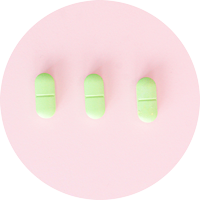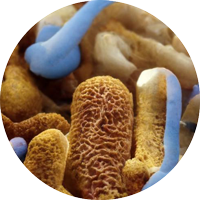Ankylosing Spondylitis Treatments
Ankylosing Spondylitis Treatments
While there is no ‘cure’ yet for ankylosing spondylitis there are a number of treatments on offer. All are designed to help relieve pain, reduce inflammation and slow disease progression. Inflammation causes tissue scarring which can lead to bone fusing and greater pain and mobility issues further down the line.
This main focus of Gut Heroes is on targeting gut health to manage AS. You can learn more about this here.
In pain right now? 🟢 Click here.
Non Steroidal Anti Inflammatories (NSAIDs)
Pain Relief in 20 - 30 Minutes
NSAIDs, like Ibuprofen, target inflammation and are usually prescribed in the first instance by doctors.
While they don’t address the root cause of ankylosing spondylitis flares they can help reduce inflammation and offer some pain relief.

Tip: Trying the no starch diet? Some find they have to stop taking NSAIDs first before they see results.
Examples of NSAIDs: Ibuprofen, Naproxen, Diclofenac, Etoricoxib
Immunosuppressants and Biologics
Pain Relief in 7 Days - 3 Months
Immunosuppressants target the immune system.
The idea is that autoimmune diseases are the result of “overreactive” immune systems and these treatments are designed to dial it down.
Broadly speaking there are two approaches:

Methotrexate is a generalised immunosuppressant (rather than a biologic, which is more targeted) and offers a more scattergun approach. In higher doses it is used as a chemotherapy drug to treat cancers.
Biologics are more targeted (but also a lot more expensive). All biologics target inflammatory cytokines, proteins that signal to the immune system. Different biologics target different cytokines.
TNF biologics (anti-tumour necrosis factor) are the most widely used, followed by IL-17A biologics (Interleukin 17A) and IL 12/23 biologics.
JAK inhibitors, which are small molecules, also target immune pathways but are not considered biologics.
Fast acting and very effective for some people. Typically they can be self administered by injection every 1 – 2 weeks (depending on the biologic and the dose).
Tip: Different biologics work differently for different people. It may take some trial and error to find one which works for you.
Examples of TNF Biologics: Humira, Cimzia, Enbrel, Infliximab
Examples of IL-17A Biologics: Cosentyx, Stelera
Examples of Other Immunosuppressants: Methotrexate
Stretching and Exercise
Pain Relief Time: Variable!
The National Axial Spondyloarthritis Society call exercise “the single most important thing you can do to help yourself”.
Stretching and exercise is something all rheumatologists and physiotherapists agree should be part of any ankylosing spondylitis treatment plan.

Spinal stretches, yoga, pilates are great for flexibility and movement. Daily walks and cardio that doesn’t aggravate the AS is also a fantastic way to manage this disorder.
Extremely effective, inexpensive (or free!) and provides additional benefits such as increased fitness, more energy, better focus and better heart health.
None. This is essential and something all AS patients should engage in.
Tip: Yoga is consistently seen as an effective exercise for treating ankylosing spondylitis.
Examples: Yoga, Pilates, Walking, Swimming, Cycling, Strength Training
Gut Health and Microbiome
Pain Relief in 7 Days - 12 Months
“The human microbiome might be a major player in autoimmunity”, such as ankylosing spondylitis.
The idea behind focusing on diet and gut health to treat ankylosing spondylitis is to target the source of the problem.
Many microbiologists believe this is something called dybiosis.

Where microbiota populations have become imbalanced and/or there is damage to gut lining in the patient. This is sometimes known as ‘gut permeability’ or ‘leaky gut’.
The first way to approach this is to determine which microbiota patients should strive to have more (and less) of and eat accordingly. The second is to engage in behaviours that help repair the mucosal gut lining.
The diet which many ankylosing spondylitis patients have adopted is the Low/No Starch Diet. Studies have shown a connection between klebsiella bacteria overgrowth and the HLA-B27 gene variant found in 95% of AS patients.
This diet seeks to reduce levels of the klebsiella bacteria in the gut and mitigate the body’s ‘over-reactive’ immune response which leads to pain and inflammation.
The klebsiella bacteria feeds off starch and lactose and the theory is that by reducing or eliminating your intake or starch and dairy you starve off the klebsiella bacteria, remove the associated immune response and help eliminate inflammation and pain.
For many this can prove as effective, if not more effective, than many medications including biologics and NSAIDs. It also doesn’t come with any of the dangers or side effects.
This is hard work and requires willpower, determination and patience. There is no pill, injection or quick fix.
Tip: Start from scratch and build your wellness plan from the ground up.
Examples: Treating Gut Dysbiosis and Gut Permeability